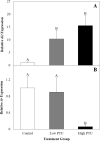Developmental thyroid disruption causes long-term impacts on immune cell function and transcriptional responses to pathogen in a small fish model
- PMID: 34262125
- PMCID: PMC8280131
- DOI: 10.1038/s41598-021-93929-8
Developmental thyroid disruption causes long-term impacts on immune cell function and transcriptional responses to pathogen in a small fish model
Abstract
Current evidence suggests thyroid hormones (THs) impact development of the immune system, but few studies have explored the connection between the thyroid and immune systems, especially in fish. This is important as some environmental contaminants disrupt TH homeostasis and may thus have negative impacts on the immune system. To determine the long-term consequences of early life stage (ELS) hypothyroidism on immune function, fathead minnows were exposed to the model thyroid hormone suppressant propylthiouracil (PTU) from < 1 to 30 days post hatch. Fish were transferred to clean water and raised to adulthood (5-7 months post hatch) at which time, several aspects of immune function were evaluated. Ex vivo assessment of immune cell function revealed significant decreases (1.2-fold) in the phagocytic cell activity of PTU-treated fish relative to the controls. Fish were also injected with Yersinia ruckeri to evaluate their in vivo immune responses across a suite of endpoints (i.e., transcriptomic analysis, leukocyte counts, spleen index, hematocrit, bacterial load and pathogen resistance). The transcriptomic response to infection was significantly different between control and PTU-treated fish, though no differences in bacterial load or pathogen resistance were noted. Overall, these results suggest that early life stage TH suppression causes long-term impacts on immune function at the molecular and cellular levels suggesting a key role for TH signaling in normal immune system development. This study lays the foundation for further exploration into thyroid-immune crosstalk in fish. This is noteworthy as disruption of the thyroid system during development, which can occur in response to chemicals present in the environment, may have lasting effects on immune function in adulthood.
© 2021. The Author(s).
Conflict of interest statement
The authors declare no competing interests.
Figures






References
Publication types
MeSH terms
Substances
LinkOut - more resources
Full Text Sources
Molecular Biology Databases

